Neoteric Solvents Market
Neoteric Solvents Market Size and Share Forecast Outlook 2025 to 2035
Neoteric solvents market is projected to grow from USD 0.7 billion in 2025 to USD 1.4 billion by 2035, at a CAGR of 7.3%. Ionic Liquids will dominate with a 51.4% market share, while pharmaceuticals & life sciences will lead the application segment with a 39.7% share.
Neoteric Solvents Market Forecast and Outlook 2025 to 2035
The global neoteric solvents market is set to grow from USD 0.69 billion in 2025 to USD 1.4 billion by 2035, adding USD 0.71 billion in new revenue and advancing at a CAGR of 7.3%. Growth is driven by escalating demand for sustainable chemical processing, expanding pharmaceutical synthesis infrastructure across regulated markets, and accelerating green chemistry requirements among manufacturing organizations seeking environmentally benign solvent solutions.
Quick Stats for Neoteric Solvents Market
- Neoteric Solvents Market Value (2025): USD 0.69 billion
- Neoteric Solvents Market Forecast Value (2035): USD 1.4 billion
- Neoteric Solvents Market Forecast CAGR: 7.3%
- Leading Solvent Type in Neoteric Solvents Market: Ionic Liquids (51.4%)
- Key Growth Regions in Neoteric Solvents Market: Asia Pacific, North America, and Europe
- Top Players in Neoteric Solvents Market: Merck KGaA, BASF SE, Solvionic SA, Proionic GmbH, Scionix Ltd
- Where revenue comes from - Now Vs Next (Industry-level view)

Neoteric solvent technologies are increasingly recognized as essential materials for pharmaceutical researchers, offering superior selectivity capabilities, thermal stability advantages, and comprehensive tunability characteristics compared to traditional volatile organic compound approaches.
Ionic liquid formulations dominate the market, favored in pharmaceutical and chemical processing environments for their established designer solvent properties, providing negligible vapor pressure mechanisms, wide electrochemical window capabilities, and molecular customization across diverse synthesis applications and research demographics.
Pharmaceuticals and life sciences applications remain fundamental in utilization protocols where drug synthesis and catalytic reaction match process requirements and environmental compliance confidence standards. Chemical and industrial sectors are advancing among application categories as specialized green manufacturing facility networks expand and sustainable process chemistry infrastructure increases accessibility in production-convenient locations with regulatory approval structures.
Geographic concentration demonstrates dynamic growth patterns with India and China leading expansion, supported by rising pharmaceutical manufacturing capacity, green chemistry consciousness expansion among research populations, and sustainable solvent adoption programs in production centers.
USA, Japan, Germany, South Korea, and Brazil demonstrate robust development through established pharmaceutical research ecosystems, regulatory framework maturity for environmental standards, and continued acceptance of alternative solvent procedures. Competitive advantage is consolidating around molecular design profiles, purity specification documentation, electrochemical property compatibility, and integrated green chemistry portfolios rather than standalone ionic liquid formulations alone.
The first half of the decade will witness the market climbing from USD 0.69 billion to USD 0.95 billion, adding USD 0.26 billion in value, which constitutes 36% of the total forecast growth period. This phase will be characterized by the continued dominance of ionic liquid methodologies in pharmaceutical synthesis settings, combined with accelerating adoption of deep eutectic solvent technologies in bio-extraction applications where natural origin and biodegradability create favorable sustainability outcomes.
The latter half will witness sustained expansion from USD 0.95 billion to USD 1.4 billion, representing an addition of 0.45 billion or 64% of the decade's growth, defined by broadening acceptance of supercritical fluid formulations and integration of bio-based solvent platforms across mainstream chemical manufacturing facilities.
| Period | Primary Revenue Buckets | Share | Notes |
|---|---|---|---|
| Today | Ionic Liquids | 51.4% | Designer solvent dominance |
| Pharmaceuticals & Life Sciences | 39.7% | Primary application | |
| Imidazolium ILs | 27.3% | Leading IL type | |
| Natural DES | 18.6% | Sustainable segment | |
| Drug Synthesis | 18.5% | Core pharmaceutical use | |
| Future (3-5 yrs) | Task-Specific ILs | 38-44% | Customization advancement |
| Supercritical CO2 Systems | 32-38% | Clean extraction | |
| Bio-based Solvents | 28-34% | Renewable sources | |
| Drug Delivery Systems | 24-30% | Therapeutic expansion | |
| Energy Storage Applications | 22-28% | Electrolyte development | |
| Catalytic Processes | 18-24% | Green synthesis | |
| Emerging Markets | 35-41% | Research expansion |
Neoteric Solvents Market Key Takeaways
At-a-Glance Metrics
| Metric | Value |
|---|---|
| Market Value (2025) → | USD 0.69 billion |
| Market Forecast (2035) ↑ | USD 1.4 billion |
| Growth Rate ★ | 7.3% CAGR |
| Leading Solvent Type → | Ionic Liquids |
| Primary Application → | Pharmaceuticals & Life Sciences |
The market demonstrates exceptional fundamentals with Ionic Liquids capturing a commanding 51.4% share through superior tunability characteristics, established non-volatile advantages, and proven selectivity profiles across pharmaceutical synthesis applications.
Pharmaceuticals and life sciences drive primary application demand at 39.7% share, supported by established green chemistry infrastructure and drug development requirements that maintain process innovation across diverse research segments.
Geographic concentration remains anchored in Asia Pacific and North America with emerging market leadership through pharmaceutical manufacturing expansion and sustainable chemistry infrastructure development, while developed markets show accelerated adoption rates driven by environmental regulation demographics and green synthesis procedure preferences.
Imperatives for Stakeholders in Neoteric Solvents Market
Design for sustainability and tunability, not just solvent replacement
- Offer complete green chemistry solutions: neoteric solvent products + molecular design services + process optimization support + environmental assessment systems + regulatory guidance platforms.
- Preconfigured application packages: pharmaceutical synthesis specifications, extraction process configurations, catalysis programs, and electrochemical protocols for diverse research requirements.
Regulatory readiness for pharmaceutical applications
- Comprehensive purity documentation, environmental compliance systems, and safety infrastructure (toxicity assessment, biodegradability testing, lifecycle analysis protocols).
Affordability-by-design approach
- Cost-optimized product portfolios, flexible research pricing models, academic loyalty programs, and transparent total solvent cost documentation.
Technical support-focused market penetration
- Established process chemistry workshops + comprehensive certification programs (solvent selection, process design, scale-up management); direct researcher engagement for relationship development and application confidence building.
Segmental Analysis
The market segments by solvent type into ionic liquids, deep eutectic solvents, supercritical fluids, bio-based solvents, and others, representing the evolution from conventional volatile organic compounds toward sustainable alternatives with designer properties, environmental compatibility, and application-specific characteristics. Within ionic liquids (51.4%), the sub-segmentation reveals imidazolium ILs (27.3%), pyridinium ILs, phosphonium ILs, and ammonium ILs, reflecting distinct structural variations for cation optimization and anion selection versus electrochemical window tuning and viscosity control.
The deep eutectic solvents segment further divides into natural DES (18.6%), choline chloride-based DES, quaternary ammonium DES, and metal-salt based DES, demonstrating varied hydrogen bond donor combinations and eutectic point optimization. The application segmentation shows pharmaceuticals and life sciences' commanding 39.7% position, with drug synthesis (18.5%), drug delivery, bio-extraction, and catalysis subsegments, followed by chemical/industrial, energy/electronics, agriculture, and others, indicating varied research specialization levels and process chemistry concentrations.
The segmentation structure reveals neoteric solvent evolution from basic volatile organic compound replacement toward comprehensive green chemistry platforms with enhanced molecular design characteristics and multi-dimensional sustainability capabilities, while application diversity spans from pharmaceutical synthesis to energy storage protocols requiring specialized physicochemical properties.
What makes Ionic Liquids Command the Largest Share in the Neoteric Solvents Market?
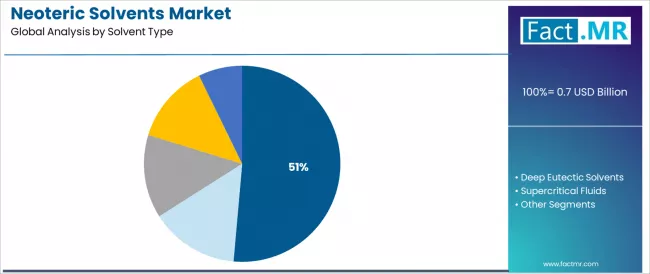
Ionic Liquids command the leading position in the neoteric solvents market with a 51.4% market share through superior designer solvent characteristics, including molecular tunability capacity, negligible vapor pressure properties, and wide electrochemical window pathways that enable researchers to achieve predictable process outcomes across varied reaction conditions and diverse application demographics.
The segment benefits from customization advantages through cation-anion combination flexibility, thermal stability results without decomposition limitations, and established research documentation without requiring extensive process validation infrastructure. Advanced synthesis technology enables viscosity optimization, hydrophobicity variation, and task-specific functionality customization, where process selectivity and environmental compliance represent critical green chemistry performance requirements.
Imidazolium ionic liquids hold significant share within the ionic liquid segment, appealing to researchers seeking comprehensive catalytic capabilities for organic synthesis applications. Ionic liquid products differentiate through proven non-volatile profiles, researcher familiarity advantages, and integration with established green chemistry protocols that enhance process confidence while maintaining environmentally acceptable synthesis outcomes for diverse pharmaceutical applications.
Key market characteristics:
- Advanced tunability properties with cation-anion selection and functionalization options for application-specific optimization
- Superior thermal stability, enabling high-temperature reactions and process intensification for chemical manufacturing operations
- Comprehensive electrochemical windows, including wide voltage ranges and ionic conductivity for battery and electrochemical applications
Why do Deep Eutectic Solvents Represent a Specialized Green Chemistry Segment?
Deep eutectic solvents maintain specialized market position through sustainability characteristics and natural component capabilities. These products appeal to researchers and manufacturers seeking biodegradable alternatives with comprehensive green chemistry credentials, offering hydrogen bond formation patterns and eutectic point depression approaches through natural compound combinations. Market adoption is driven by bio-extraction applications, emphasizing natural product isolation and sustainable processing through renewable feedstock systems.
Which Application Area Dominates in the Neoteric Solvents Market?
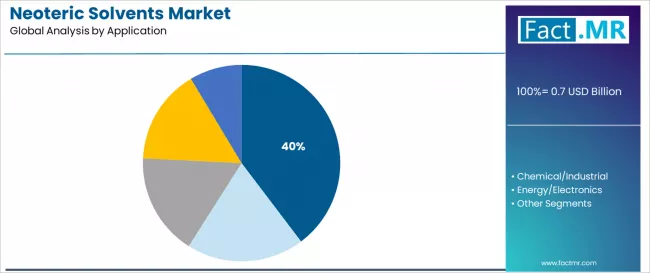
Pharmaceuticals and life sciences demonstrate application leadership in the neoteric solvents market with a 39.7% share due to widespread drug development requirements and established focus on green synthesis, API production, and biocatalysis that maximizes process sustainability while maintaining synthetic efficiency characteristics.
Pharmaceutical researchers and process chemists prioritize neoteric solvents for reaction media optimization, chiral separation enhancement, and integration with established drug discovery programs that enables coordinated synthesis experiences across multiple development stages. The segment benefits from substantial green chemistry standardization and process documentation that emphasizes ionic liquid-based approaches for sustainable pharmaceutical manufacturing across diverse therapeutic categories.
Drug synthesis captures significant share within the pharmaceuticals segment, demonstrating researcher preference for alternative reaction media. Pharmaceutical pipeline expansion incorporates neoteric solvents as essential green chemistry components for API production, while continuous manufacturing adoption increases demand for solvent systems that meet sustainability requirements and ensure process intensification capabilities.
What drives Chemical and Industrial Adoption in Manufacturing Process Applications?
Chemical and industrial sectors capture substantial application share through comprehensive requirements in catalytic processes, separation operations, and electrochemical synthesis optimization.
These applications demand sophisticated solvent protocols capable of achieving process efficiency while providing environmental compliance and recyclability characteristics, appealing to manufacturers and process engineers seeking evidence-based sustainability advantages beyond conventional organic solvent approaches.
What establishes Imidazolium Ionic Liquids' Leadership in Ionic Liquid Segment?
Imidazolium ionic liquids establish subsegment leadership within the ionic liquid category with commanding 27.3% share due to comprehensive structural versatility and sustained focus on catalytic activity, electrochemical stability, and synthesis accessibility that maximizes application breadth while maintaining appropriate performance standards.
Researchers and industrial chemists prioritize imidazolium ILs for established synthetic routes, extensive literature documentation, and integration with diverse anion combinations that enables coordinated process development experiences across multiple application categories.
The subsegment benefits from substantial commercial availability maturity and property characterization campaigns that emphasize imidazolium-based platforms for mainstream ionic liquid applications.
Pharmaceutical synthesis expansion incorporates imidazolium ILs as proven catalytic media for organic reactions, while electrochemical device development increases demand for conductive ionic liquids that meet stability requirements and ensure wide voltage window capabilities.
Ionic liquid dynamics include:
- Strong growth in task-specific ionic liquids requiring functionalized structures and targeted property optimization arrangements
- Increasing adoption in protic ionic liquids for proton transfer applications and fuel cell electrolyte positioning
- Rising integration with magnetic ionic liquids for separation processes and recyclability enhancement development
How are Natural Deep Eutectic Solvents Advancing Sustainable Extraction Requirements?
Natural deep eutectic solvents capture growing subsegment share through established biodegradability frameworks, complex natural component capabilities, and integrated green extraction protocols. The segment demonstrates specialized sustainable chemistry expertise across diverse bio-based applications, with advanced biocompatibility properties and renewable feedstock infrastructure gaining traction in natural product programs while toxicity frameworks drive continued formulation development requiring careful balance between extraction efficiency and environmental safety assurance.
What are the Drivers, Restraints, and Key Trends of the Neoteric Solvents Market?
| Category | Factor | Impact | Why It Matters |
|---|---|---|---|
| Driver | Rising environmental regulations & green chemistry adoption (sustainability mandates, VOC restrictions) | ★★★★★ | Regulatory requirements enable neoteric solvent demand for sustainable processing; increasing environmental consciousness drives alternative solvent adoption across pharmaceutical markets and diverse chemical segments. |
| Driver | Growth in pharmaceutical R&D and API manufacturing (drug development, process intensification) | ★★★★★ | Drives demand for designer solvent systems and green synthesis protocols; researchers providing sustainable processes gain competitive advantage in environmentally-focused pharmaceutical segments. |
| Driver | Expanding renewable energy and battery technology (electrolyte applications, energy storage) | ★★★★☆ | Manufacturers demand stable electrolyte materials and wide electrochemical window systems; energy storage visibility expanding addressable segments beyond traditional solvent demographics and pharmaceutical research clientele. |
| Restraint | High production costs & limited commercial availability (synthesis complexity, scale-up challenges) | ★★★★★ | Cost-conscious researchers face budget limitations and application feasibility constraints, restricting technology adoption and affecting penetration in price-sensitive industries and commercial-scale manufacturing operations. |
| Restraint | Limited toxicity data & regulatory uncertainty (safety assessment gaps, approval pathways) | ★★★☆☆ | Manufacturers face regulatory compliance complexity and safety validation requirements; increases adoption barriers and affects penetration in risk-averse pharmaceutical production and commercial manufacturing facilities. |
| Trend | Task-specific ionic liquid development & molecular design (structure-property relationships, computational design) | ★★★★★ | Growing researcher demand for customized solvent properties and application-optimized structures beyond general-purpose ionic liquids; molecular engineering becomes core differentiation strategy for specialized application positioning. |
| Trend | Bio-based feedstock integration & circular economy approaches (renewable sources, solvent recycling) | ★★★★☆ | Green chemistry evolving beyond synthetic ionic liquids toward bio-derived alternatives; sustainability positioning drives enhanced lifecycle performance and reduced environmental footprint in progressive research environments. |
Analysis of the Neoteric Solvents Market by Key Country
The neoteric solvents market demonstrates robust regional growth dynamics with emerging leaders including India (8.1% CAGR) and China (7.8% CAGR) driving expansion through pharmaceutical research programs and green chemistry infrastructure development. Strong Performers encompass the USA (7.4% CAGR), Japan (6.9% CAGR), and Germany (6.7% CAGR), benefiting from established pharmaceutical R&D infrastructure and sustainable chemistry demographics. Developed Markets feature South Korea (6.4% CAGR) and Brazil (5.9% CAGR), where green technology normalization and research investment expertise support consistent growth patterns.
Regional synthesis reveals Asian markets leading adoption through comprehensive pharmaceutical capacity positioning and green chemistry investment expansion, while Western countries demonstrate measured growth potential supported by environmental regulation preferences and advanced research facility influence. Latin American markets show solid development driven by pharmaceutical manufacturing growth and sustainable chemistry infrastructure.
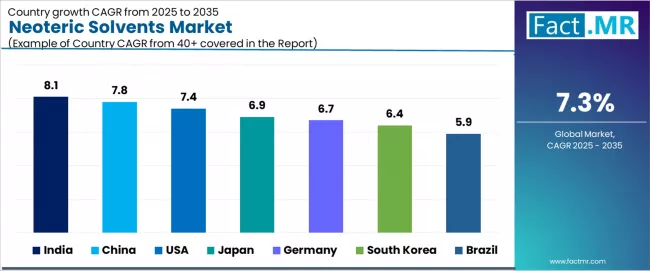
| Region/Country | 2025-2035 Growth | How to win | What to watch out |
|---|---|---|---|
| India | 8.1% | Focus on cost-effective IL portfolios | Pharmaceutical manufacturing expansion and green chemistry adoption |
| China | 7.8% | Lead with commercial-scale positioning | Research investment growth and environmental regulation implementation |
| USA | 7.4% | Provide pharmaceutical-grade technologies | Strong pharmaceutical R&D and green chemistry leadership |
| Japan | 6.9% | Deliver high-purity solutions | Advanced materials research and electrochemical applications |
| Germany | 6.7% | Maintain quality-focused positioning | Chemical industry transformation and sustainability compliance |
| South Korea | 6.4% | Push battery application programs | Energy storage development and electronics manufacturing |
| Brazil | 5.9% | Offer agrochemical extraction strategies | Bio-based economy growth and natural product extraction |
India Drives Fastest Market Growth
India establishes fastest market growth through progressive pharmaceutical manufacturing expansion and comprehensive green chemistry infrastructure development, positioning neoteric solvent technologies as essential sustainable solutions in API production facilities and emerging pharmaceutical research operations.
The country's 8.1% growth rate reflects pharmaceutical manufacturing expansion momentum combined with green chemistry adoption supporting environmental compliance that encourages the deployment of cost-effective ionic liquid products in diverse synthesis settings.
Growth concentrates in major pharmaceutical clusters, including Hyderabad, Ahmedabad, and Mumbai, where research facilities showcase increasing capacity for sustainable process adoption that appeals to export-focused manufacturers demanding validated green chemistry and regulatory compliance outcomes.
Indian pharmaceutical researchers are developing standardized green synthesis protocols that combine imported high-purity ionic liquids with domestic process development partnerships, including contract manufacturing expansion and sustainable chemistry research growth.
Distribution channels through specialty chemical distributors and research suppliers expand market access, while chemist training initiatives support adoption across diverse facility types and application specialization levels.
China Emerges as Green Chemistry Research Leader
In Beijing, Shanghai, and Guangdong regions, pharmaceutical research institutes and chemical manufacturing facilities are adopting advanced neoteric solvent technologies as essential green chemistry tools for sustainable production operations, driven by research investment growth momentum combined with environmental regulation implementation supporting cleaner manufacturing that emphasizes the importance of alternative solvent systems.
The market holds a 7.8% growth rate, supported by government research funding and green chemistry initiative investment that promote ionic liquid adoption for innovation-oriented applications. Chinese researchers are favoring task-specific ionic liquids that provide comprehensive process optimization and regulatory compliance, particularly appealing in pharmaceutical development zones where environmental performance and synthesis efficiency represent critical competitive factors.
Market expansion benefits from substantial research institute investment and pharmaceutical facility establishment that enable widespread adoption of evidence-based green chemistry for diverse API manufacturing applications. Industry adoption follows patterns established in sustainable technology excellence, where process efficiency advantages and environmental compliance documentation drive researcher confidence and technology commercialization.
USA Shows Pharmaceutical R&D Leadership
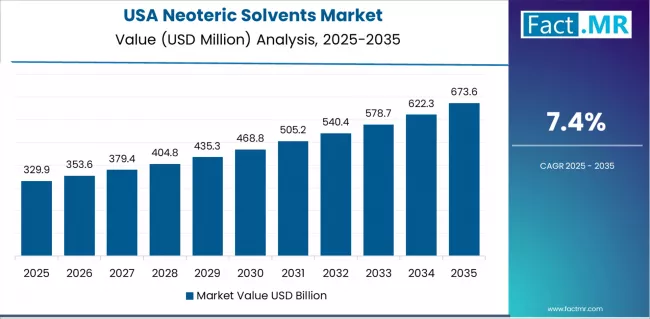
USA establishes pharmaceutical R&D leadership through comprehensive research infrastructure and established green chemistry ecosystem, integrating neoteric solvent technologies across pharmaceutical companies, academic institutions, and specialty chemical manufacturers.
The country's 7.4% growth rate reflects strong pharmaceutical R&D investment combined with green chemistry leadership supporting innovation that drives widespread deployment of high-purity ionic liquid products in research and development applications. Growth concentrates in established pharmaceutical regions, including Massachusetts, California, and New Jersey, where research organizations showcase advanced green chemistry adoption that appeals to innovation-focused pharmaceutical companies seeking sustainable process outcomes and comprehensive technical documentation.
American pharmaceutical researchers leverage established supplier relationships and comprehensive regulatory frameworks, including FDA interaction readiness and green chemistry principle programs that create process confidence and sustainability assurance. The market benefits from substantial pharmaceutical pipeline investment and continuous manufacturing development that encourage premium product purchases while supporting continuous innovation investments and process chemistry funding.
Japan Demonstrates Advanced Materials Research Preferences
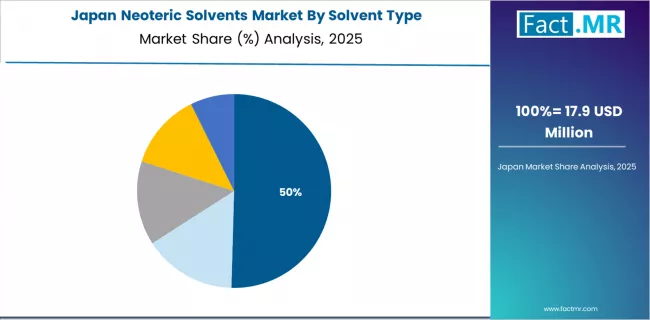
Japan's sophisticated research market demonstrates established neoteric solvent adoption with documented materials science emphasis in electrochemical applications and advanced synthesis through comprehensive university laboratories and corporate R&D centers. The country maintains a 6.9% growth rate, reflecting advanced materials research requirements combined with electrochemical application development supporting specialized technology growth.
Metropolitan research centers, including Tokyo, Osaka, and Kyoto regions, showcase innovation-driven priorities where neoteric solvent technologies integrate with established materials science cultures and meticulous characterization practices to optimize electrochemical performance and maintain battery development standards under demanding energy storage requirements.
Japanese researchers prioritize comprehensive property characterization and rigorous purity validation in ionic liquid application, creating demand for high-quality products with exceptional specifications, including electrochemical stability data, thermal decomposition profiles, and validated conductivity measurements. The market benefits from established battery manufacturing expertise and advanced materials research excellence that provide premium positioning opportunities and comply with strict Japanese quality standards.
Germany Shows Chemical Industry Transformation Integration
Germany's advanced chemical market demonstrates sophisticated neoteric solvent integration with documented sustainability emphasis in process chemistry transformation and industrial application through established chemical companies and university research networks. The country leverages chemical industry transformation momentum combined with sustainability compliance approaches to maintain a 6.7% growth rate.
Premium chemical production centers, including Bavaria, North Rhine-Westphalia, and Baden-Württemberg, showcase green chemistry-driven priorities where neoteric solvent technologies integrate with established chemical engineering cultures and comprehensive environmental practices to optimize process sustainability and ensure appropriate regulatory compliance.
German chemical engineers prioritize comprehensive lifecycle assessment and extensive environmental documentation in solvent technology implementation, creating demand for sustainable products with thorough characteristics, including biodegradability data, toxicity assessment, and renewable content verification. The market benefits from established chemical industry segments and green chemistry leadership that provide premium positioning opportunities and compliance with strict German environmental regulations.
South Korea Shows Energy Storage Application Leadership
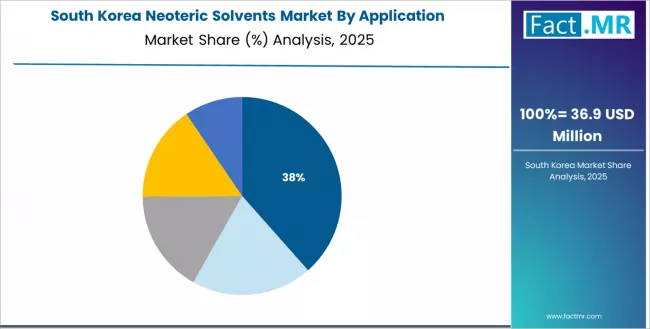
South Korea's advanced technology market demonstrates progressive neoteric solvent integration with documented battery emphasis in electrolyte development and energy storage through comprehensive battery manufacturers and materials research institutions. The country maintains a 6.4% growth rate, driven by energy storage development combined with electronics manufacturing supporting advanced materials adoption.
Key technology centers, including Seoul, Incheon, and Ulsan regions, showcase battery-driven demand approaches where neoteric solvent technologies integrate with established electrochemical engineering practices and advanced manufacturing systems to optimize electrolyte performance and maintain competitive positioning under intensive global battery market requirements.
Korean battery manufacturers prioritize comprehensive electrochemical validation and extensive performance testing in ionic liquid electrolyte implementation, creating demand for high-performance products with validated characteristics, including wide temperature range stability, high ionic conductivity, and non-flammability documentation. The market benefits from established battery manufacturing leadership and electric vehicle supply chain integration that provide advanced application positioning opportunities and maintain alignment with Korean industrial technology strategies.
Brazil Shows Bio-based Economy Integration
Brazil's emerging green economy market demonstrates progressive neoteric solvent adoption with documented natural product emphasis in bio-extraction applications and agrochemical processing through established research universities and natural product companies. The country maintains a 5.9% growth rate, driven by bio-based economy growth combined with natural product extraction supporting sustainable processing operations.
Major research regions, including São Paulo, Rio de Janeiro, and Minas Gerais, showcase extraction-driven application approaches where neoteric solvent technologies integrate with established biodiversity resources and green extraction practices to optimize natural compound isolation and maintain environmental sustainability under regional bioeconomy development objectives.
Brazilian researchers prioritize natural deep eutectic solvent formulations and comprehensive biodegradability validation in extraction process development, creating demand for bio-based products with proven sustainability characteristics, including renewable feedstock sourcing, biodegradability evidence, and extraction efficiency documentation. The market benefits from established natural product research expertise and biodiversity resource availability that provide green chemistry positioning opportunities and maintain alignment with Brazilian sustainable development goals.
Europe Market Split by Country
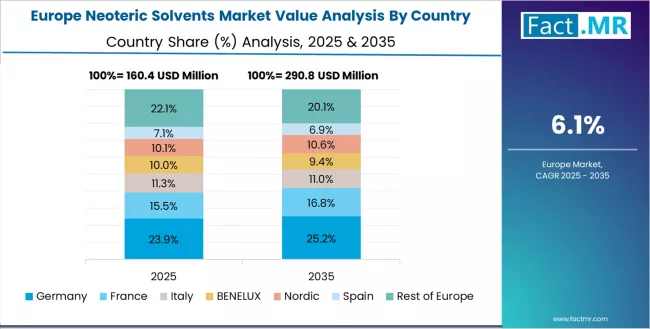
The neoteric solvents market in Europe is projected to grow from USD 145.7 million in 2025 to USD 264.2 million by 2035, representing 21.0% of the global market in 2025 and expanding to 18.8% by 2035. Germany is expected to maintain its leadership position with USD 39.0 million in 2025, accounting for 26.8% of the European market, supported by its advanced chemical industry infrastructure and established green chemistry research networks.
France follows with USD 27.5 million, representing 18.9% of the European market in 2025, driven by comprehensive pharmaceutical research integration and sustainable chemistry concentration. UK holds USD 25.2 million with 17.3% market share through established academic research acceptance and pharmaceutical company density. Italy commands USD 20.7 million representing 14.2% share, while Spain accounts for USD 16.9 million or 11.6% in 2025.
The rest of Europe region maintains USD 16.3 million, representing 11.2% of the European market, attributed to increasing green chemistry adoption in Nordic countries and emerging Eastern European pharmaceutical research sectors implementing sustainable chemistry programs.
Competitive Landscape of the Neoteric Solvents Market
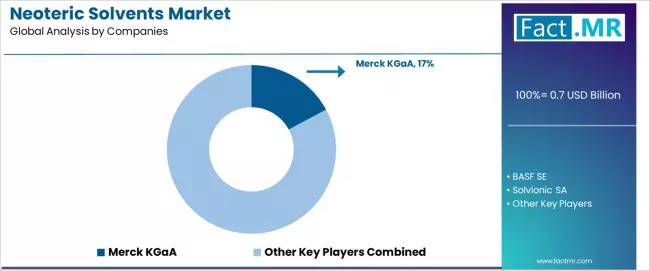
The neoteric solvents market exhibits a moderately consolidated competitive structure with approximately 30-50 active players operating across global specialty chemical networks and regional research chemical distribution portfolios. Merck KGaA maintains market leadership at a 17.2% share, reflecting strong product portfolio positioning across diverse ionic liquid formulations with sophisticated global research strategies.
This competitive landscape demonstrates the maturation of neoteric solvent technology, where established players leverage synthesis expertise advantages, extensive purity documentation, and technical support programs to maintain dominant positions, while emerging specialized ionic liquid manufacturers and academic spin-offs create niche opportunities through custom synthesis offerings and application-specific formulation strategies.
Market leadership is maintained through several critical competitive advantages extending beyond manufacturing capabilities and product portfolios. Global distribution networks enable leading players to navigate diverse research requirements and access varied customer segments including pharmaceutical companies, academic institutions, and chemical manufacturers.
Technical support infrastructure and application development program availability represent crucial differentiators in neoteric solvent categories, where decades of green chemistry expertise, molecular design protocols, and process optimization frameworks create purchasing preference among research-focused customers.
Manufacturing efficiency in specialty synthesis operations, supply chain purity management, and custom formulation capabilities separate major suppliers from smaller competitors, while comprehensive characterization documentation addressing physicochemical properties, electrochemical data, and toxicity assessment strengthen market position and researcher confidence.
The market demonstrates emerging differentiation opportunities in task-specific ionic liquid categories and bio-based deep eutectic technologies, where traditional general-purpose ionic liquids face competition from application-focused entrants offering customized property advantages. However, significant competitive advantages persist in established imidazolium ionic liquid categories through comprehensive availability portfolios and researcher relationship depth.
Premium positioning strategies with pharmaceutical-grade purity and custom synthesis capabilities command margin premiums through superior quality assurance and application-specific optimization.
Specialized product portfolios combining multiple ionic liquid families with deep eutectic solvent offerings create comprehensive positioning that justifies higher price points beyond commodity research chemical competition. Integrated green chemistry solution offerings emphasizing process consultation, unified technical support, and cross-application expertise programs generate brand loyalty and sourcing preferences beyond transactional ionic liquid purchases.
| Stakeholder | What they actually control | Typical strengths | Typical blind spots |
|---|---|---|---|
| Global specialty chemical corporations | Comprehensive synthesis capabilities; distribution networks; technical documentation | Brand recognition; quality assurance; researcher relationships; production scale | Innovation speed; custom synthesis; niche applications; academic pricing |
| Specialized ionic liquid companies | Synthesis expertise; custom formulation; molecular design | Product differentiation; technical sophistication; application engineering; researcher loyalty | Market penetration; distribution infrastructure; price competitiveness; geographic coverage |
| Academic spin-offs | Novel synthesis; innovative structures; research collaboration | Innovation leadership; academic credibility; custom capabilities; intellectual property | Commercial scaling; manufacturing capacity; distribution networks; price optimization |
| Research chemical distributors | Market access; researcher relationships; logistics services | Customer reach; product availability; convenience positioning; catalog breadth; repeat business | Synthesis control; product development; technical innovation; premium positioning |
| Contract manufacturers | Custom synthesis; scale-up expertise; production services | Flexibility capabilities; confidentiality assurance; technical services; manufacturing knowledge | Product portfolio; market presence; brand recognition; direct researcher engagement |
Key Players in the Neoteric Solvents Market
- Merck KGaA
- BASF SE
- Solvionic SA
- Proionic GmbH
- Scionix Ltd
- IoLiTec Ionic Liquids Technologies GmbH
- Tokyo Chemical Industry Co. Ltd.
- Sanyo Chemical Solutions
- Sigma-Aldrich (MilliporeSigma)
- DeepMaterial Tech Co.
Scope of the Report
| Items | Values |
|---|---|
| Quantitative Units (2025) | USD 0.69 billion |
| Solvent Type | Ionic Liquids, Deep Eutectic Solvents, Supercritical Fluids, Bio-based Solvents, Others |
| Application | Pharmaceuticals & Life Sciences, Chemical/Industrial, Energy/Electronics, Agriculture, Others |
| Regions Covered | North America, Europe, Asia Pacific, Latin America, Middle East & Africa |
| Countries Covered | India, China, USA, Japan, Germany, South Korea, Brazil, and 15+ additional countries |
| Key Companies Profiled | Merck KGaA, BASF SE, Solvionic SA, Proionic GmbH, Scionix Ltd, IoLiTec Ionic Liquids Technologies GmbH, Tokyo Chemical Industry Co. Ltd. |
| Additional Attributes | Dollar sales by solvent type and application categories, regional adoption trends across Asia Pacific, North America, and Europe, competitive landscape with established specialty chemical corporations and specialized ionic liquid companies, researcher preferences for ionic liquid methodologies and pharmaceutical compliance, integration with pharmaceutical synthesis operations and chemical manufacturing facilities, innovations in task-specific ionic liquid technologies and bio-based deep eutectic solvents, and development of sophisticated molecular design systems with enhanced tunability profiles and comprehensive property characterization frameworks. |
Neoteric Solvents Market by Segments
-
Solvent Type :
- Ionic Liquids
- Imidazolium ILs
- Pyridinium ILs
- Phosphonium ILs
- Ammonium ILs
- Deep Eutectic Solvents
- Natural DES
- Choline Chloride-Based DES
- Quaternary Ammonium DES
- Metal-Salt Based DES
- Supercritical Fluids
- Bio-based Solvents
- Others
- Ionic Liquids
-
Application :
- Pharmaceuticals & Life Sciences
- Drug Synthesis
- Drug Delivery
- Bio-extraction
- Catalysis
- Chemical/Industrial
- Energy/Electronics
- Agriculture
- Others
- Pharmaceuticals & Life Sciences
-
Region :
- North America
- USA
- Canada
- Mexico
- Europe
- Germany
- France
- UK
- Italy
- Spain
- Rest of Europe
- Asia Pacific
- India
- China
- Japan
- South Korea
- ASEAN
- Australia & New Zealand
- Rest of Asia Pacific
- Latin America
- Brazil
- Rest of Latin America
- Middle East & Africa
- GCC Countries
- South Africa
- Rest of Middle East & Africa
- North America
Table of Content
- Executive Summary
- Global Market Outlook
- Demand to side Trends
- Supply to side Trends
- Technology Roadmap Analysis
- Analysis and Recommendations
- Market Overview
- Market Coverage / Taxonomy
- Market Definition / Scope / Limitations
- Market Background
- Market Dynamics
- Drivers
- Restraints
- Opportunity
- Trends
- Scenario Forecast
- Demand in Optimistic Scenario
- Demand in Likely Scenario
- Demand in Conservative Scenario
- Opportunity Map Analysis
- Product Life Cycle Analysis
- Supply Chain Analysis
- Investment Feasibility Matrix
- Value Chain Analysis
- PESTLE and Porter’s Analysis
- Regulatory Landscape
- Regional Parent Market Outlook
- Production and Consumption Statistics
- Import and Export Statistics
- Market Dynamics
- Global Market Analysis 2020 to 2024 and Forecast, 2025 to 2035
- Historical Market Size Value (USD Million) Analysis, 2020 to 2024
- Current and Future Market Size Value (USD Million) Projections, 2025 to 2035
- Y to o to Y Growth Trend Analysis
- Absolute $ Opportunity Analysis
- Global Market Pricing Analysis 2020 to 2024 and Forecast 2025 to 2035
- Global Market Analysis 2020 to 2024 and Forecast 2025 to 2035, By Solvent Type
- Introduction / Key Findings
- Historical Market Size Value (USD Million) Analysis By Solvent Type, 2020 to 2024
- Current and Future Market Size Value (USD Million) Analysis and Forecast By Solvent Type, 2025 to 2035
- Ionic Liquids
- Deep Eutectic Solvents
- Supercritical Fluids
- Bio-based Solvents
- Others
- Y to o to Y Growth Trend Analysis By Solvent Type, 2020 to 2024
- Absolute $ Opportunity Analysis By Solvent Type, 2025 to 2035
- Global Market Analysis 2020 to 2024 and Forecast 2025 to 2035, By Application
- Introduction / Key Findings
- Historical Market Size Value (USD Million) Analysis By Application, 2020 to 2024
- Current and Future Market Size Value (USD Million) Analysis and Forecast By Application, 2025 to 2035
- Pharmaceuticals & Life Sciences
- Chemical/Industrial
- Energy/Electronics
- Agriculture
- Others
- Y to o to Y Growth Trend Analysis By Application, 2020 to 2024
- Absolute $ Opportunity Analysis By Application, 2025 to 2035
- Global Market Analysis 2020 to 2024 and Forecast 2025 to 2035, By Region
- Introduction
- Historical Market Size Value (USD Million) Analysis By Region, 2020 to 2024
- Current Market Size Value (USD Million) Analysis and Forecast By Region, 2025 to 2035
- North America
- Latin America
- Western Europe
- Eastern Europe
- East Asia
- South Asia and Pacific
- Middle East & Africa
- Market Attractiveness Analysis By Region
- North America Market Analysis 2020 to 2024 and Forecast 2025 to 2035, By Country
- Historical Market Size Value (USD Million) Trend Analysis By Market Taxonomy, 2020 to 2024
- Market Size Value (USD Million) Forecast By Market Taxonomy, 2025 to 2035
- By Country
- USA
- Canada
- Mexico
- By Solvent Type
- By Application
- By Country
- Market Attractiveness Analysis
- By Country
- By Solvent Type
- By Application
- Key Takeaways
- Latin America Market Analysis 2020 to 2024 and Forecast 2025 to 2035, By Country
- Historical Market Size Value (USD Million) Trend Analysis By Market Taxonomy, 2020 to 2024
- Market Size Value (USD Million) Forecast By Market Taxonomy, 2025 to 2035
- By Country
- Brazil
- Chile
- Rest of Latin America
- By Solvent Type
- By Application
- By Country
- Market Attractiveness Analysis
- By Country
- By Solvent Type
- By Application
- Key Takeaways
- Western Europe Market Analysis 2020 to 2024 and Forecast 2025 to 2035, By Country
- Historical Market Size Value (USD Million) Trend Analysis By Market Taxonomy, 2020 to 2024
- Market Size Value (USD Million) Forecast By Market Taxonomy, 2025 to 2035
- By Country
- Germany
- UK
- Italy
- Spain
- France
- Nordic
- BENELUX
- Rest of Western Europe
- By Solvent Type
- By Application
- By Country
- Market Attractiveness Analysis
- By Country
- By Solvent Type
- By Application
- Key Takeaways
- Eastern Europe Market Analysis 2020 to 2024 and Forecast 2025 to 2035, By Country
- Historical Market Size Value (USD Million) Trend Analysis By Market Taxonomy, 2020 to 2024
- Market Size Value (USD Million) Forecast By Market Taxonomy, 2025 to 2035
- By Country
- Russia
- Poland
- Hungary
- Balkan & Baltic
- Rest of Eastern Europe
- By Solvent Type
- By Application
- By Country
- Market Attractiveness Analysis
- By Country
- By Solvent Type
- By Application
- Key Takeaways
- East Asia Market Analysis 2020 to 2024 and Forecast 2025 to 2035, By Country
- Historical Market Size Value (USD Million) Trend Analysis By Market Taxonomy, 2020 to 2024
- Market Size Value (USD Million) Forecast By Market Taxonomy, 2025 to 2035
- By Country
- China
- Japan
- South Korea
- By Solvent Type
- By Application
- By Country
- Market Attractiveness Analysis
- By Country
- By Solvent Type
- By Application
- Key Takeaways
- South Asia and Pacific Market Analysis 2020 to 2024 and Forecast 2025 to 2035, By Country
- Historical Market Size Value (USD Million) Trend Analysis By Market Taxonomy, 2020 to 2024
- Market Size Value (USD Million) Forecast By Market Taxonomy, 2025 to 2035
- By Country
- India
- ASEAN
- Australia & New Zealand
- Rest of South Asia and Pacific
- By Solvent Type
- By Application
- By Country
- Market Attractiveness Analysis
- By Country
- By Solvent Type
- By Application
- Key Takeaways
- Middle East & Africa Market Analysis 2020 to 2024 and Forecast 2025 to 2035, By Country
- Historical Market Size Value (USD Million) Trend Analysis By Market Taxonomy, 2020 to 2024
- Market Size Value (USD Million) Forecast By Market Taxonomy, 2025 to 2035
- By Country
- Kingdom of Saudi Arabia
- Other GCC Countries
- Turkiye
- South Africa
- Other African Union
- Rest of Middle East & Africa
- By Solvent Type
- By Application
- By Country
- Market Attractiveness Analysis
- By Country
- By Solvent Type
- By Application
- Key Takeaways
- Key Countries Market Analysis
- USA
- Pricing Analysis
- Market Share Analysis, 2024
- By Solvent Type
- By Application
- Canada
- Pricing Analysis
- Market Share Analysis, 2024
- By Solvent Type
- By Application
- Mexico
- Pricing Analysis
- Market Share Analysis, 2024
- By Solvent Type
- By Application
- Brazil
- Pricing Analysis
- Market Share Analysis, 2024
- By Solvent Type
- By Application
- Chile
- Pricing Analysis
- Market Share Analysis, 2024
- By Solvent Type
- By Application
- Germany
- Pricing Analysis
- Market Share Analysis, 2024
- By Solvent Type
- By Application
- UK
- Pricing Analysis
- Market Share Analysis, 2024
- By Solvent Type
- By Application
- Italy
- Pricing Analysis
- Market Share Analysis, 2024
- By Solvent Type
- By Application
- Spain
- Pricing Analysis
- Market Share Analysis, 2024
- By Solvent Type
- By Application
- France
- Pricing Analysis
- Market Share Analysis, 2024
- By Solvent Type
- By Application
- India
- Pricing Analysis
- Market Share Analysis, 2024
- By Solvent Type
- By Application
- ASEAN
- Pricing Analysis
- Market Share Analysis, 2024
- By Solvent Type
- By Application
- Australia & New Zealand
- Pricing Analysis
- Market Share Analysis, 2024
- By Solvent Type
- By Application
- China
- Pricing Analysis
- Market Share Analysis, 2024
- By Solvent Type
- By Application
- Japan
- Pricing Analysis
- Market Share Analysis, 2024
- By Solvent Type
- By Application
- South Korea
- Pricing Analysis
- Market Share Analysis, 2024
- By Solvent Type
- By Application
- Russia
- Pricing Analysis
- Market Share Analysis, 2024
- By Solvent Type
- By Application
- Poland
- Pricing Analysis
- Market Share Analysis, 2024
- By Solvent Type
- By Application
- Hungary
- Pricing Analysis
- Market Share Analysis, 2024
- By Solvent Type
- By Application
- Kingdom of Saudi Arabia
- Pricing Analysis
- Market Share Analysis, 2024
- By Solvent Type
- By Application
- Turkiye
- Pricing Analysis
- Market Share Analysis, 2024
- By Solvent Type
- By Application
- South Africa
- Pricing Analysis
- Market Share Analysis, 2024
- By Solvent Type
- By Application
- USA
- Market Structure Analysis
- Competition Dashboard
- Competition Benchmarking
- Market Share Analysis of Top Players
- By Regional
- By Solvent Type
- By Application
- Competition Analysis
- Competition Deep Dive
- Merck KGaA
- Overview
- Product Portfolio
- Profitability by Market Segments (Product/Age /Sales Channel/Region)
- Sales Footprint
- Strategy Overview
- Marketing Strategy
- Product Strategy
- Channel Strategy
- BASF SE
- Solvionic SA
- Proionic GmbH
- Scionix Ltd
- IoLiTec Ionic Liquids Technologies GmbH
- Tokyo Chemical Industry Co. Ltd.
- Sanyo Chemical Solutions
- Sigma-Aldrich (MilliporeSigma)
- DeepMaterial Tech Co.
- Merck KGaA
- Competition Deep Dive
- Assumptions & Acronyms Used
- Research Methodology
List Of Table
- Table 1: Global Market Value (USD Million) Forecast by Region, 2020 to 2035
- Table 2: Global Market Value (USD Million) Forecast by Solvent Type, 2020 to 2035
- Table 3: Global Market Value (USD Million) Forecast by Application, 2020 to 2035
- Table 4: North America Market Value (USD Million) Forecast by Country, 2020 to 2035
- Table 5: North America Market Value (USD Million) Forecast by Solvent Type, 2020 to 2035
- Table 6: North America Market Value (USD Million) Forecast by Application, 2020 to 2035
- Table 7: Latin America Market Value (USD Million) Forecast by Country, 2020 to 2035
- Table 8: Latin America Market Value (USD Million) Forecast by Solvent Type, 2020 to 2035
- Table 9: Latin America Market Value (USD Million) Forecast by Application, 2020 to 2035
- Table 10: Western Europe Market Value (USD Million) Forecast by Country, 2020 to 2035
- Table 11: Western Europe Market Value (USD Million) Forecast by Solvent Type, 2020 to 2035
- Table 12: Western Europe Market Value (USD Million) Forecast by Application, 2020 to 2035
- Table 13: Eastern Europe Market Value (USD Million) Forecast by Country, 2020 to 2035
- Table 14: Eastern Europe Market Value (USD Million) Forecast by Solvent Type, 2020 to 2035
- Table 15: Eastern Europe Market Value (USD Million) Forecast by Application, 2020 to 2035
- Table 16: East Asia Market Value (USD Million) Forecast by Country, 2020 to 2035
- Table 17: East Asia Market Value (USD Million) Forecast by Solvent Type, 2020 to 2035
- Table 18: East Asia Market Value (USD Million) Forecast by Application, 2020 to 2035
- Table 19: South Asia and Pacific Market Value (USD Million) Forecast by Country, 2020 to 2035
- Table 20: South Asia and Pacific Market Value (USD Million) Forecast by Solvent Type, 2020 to 2035
- Table 21: South Asia and Pacific Market Value (USD Million) Forecast by Application, 2020 to 2035
- Table 22: Middle East & Africa Market Value (USD Million) Forecast by Country, 2020 to 2035
- Table 23: Middle East & Africa Market Value (USD Million) Forecast by Solvent Type, 2020 to 2035
- Table 24: Middle East & Africa Market Value (USD Million) Forecast by Application, 2020 to 2035
List Of Figures
- Figure 1: Global Market Pricing Analysis
- Figure 2: Global Market Value (USD Million) Forecast 2020 to 2035
- Figure 3: Global Market Value Share and BPS Analysis by Solvent Type, 2025 and 2035
- Figure 4: Global Market Y to o to Y Growth Comparison by Solvent Type, 2025 to 2035
- Figure 5: Global Market Attractiveness Analysis by Solvent Type
- Figure 6: Global Market Value Share and BPS Analysis by Application, 2025 and 2035
- Figure 7: Global Market Y to o to Y Growth Comparison by Application, 2025 to 2035
- Figure 8: Global Market Attractiveness Analysis by Application
- Figure 9: Global Market Value (USD Million) Share and BPS Analysis by Region, 2025 and 2035
- Figure 10: Global Market Y to o to Y Growth Comparison by Region, 2025 to 2035
- Figure 11: Global Market Attractiveness Analysis by Region
- Figure 12: North America Market Incremental Dollar Opportunity, 2025 to 2035
- Figure 13: Latin America Market Incremental Dollar Opportunity, 2025 to 2035
- Figure 14: Western Europe Market Incremental Dollar Opportunity, 2025 to 2035
- Figure 15: Eastern Europe Market Incremental Dollar Opportunity, 2025 to 2035
- Figure 16: East Asia Market Incremental Dollar Opportunity, 2025 to 2035
- Figure 17: South Asia and Pacific Market Incremental Dollar Opportunity, 2025 to 2035
- Figure 18: Middle East & Africa Market Incremental Dollar Opportunity, 2025 to 2035
- Figure 19: North America Market Value Share and BPS Analysis by Country, 2025 and 2035
- Figure 20: North America Market Value Share and BPS Analysis by Solvent Type, 2025 and 2035
- Figure 21: North America Market Y to o to Y Growth Comparison by Solvent Type, 2025 to 2035
- Figure 22: North America Market Attractiveness Analysis by Solvent Type
- Figure 23: North America Market Value Share and BPS Analysis by Application, 2025 and 2035
- Figure 24: North America Market Y to o to Y Growth Comparison by Application, 2025 to 2035
- Figure 25: North America Market Attractiveness Analysis by Application
- Figure 26: Latin America Market Value Share and BPS Analysis by Country, 2025 and 2035
- Figure 27: Latin America Market Value Share and BPS Analysis by Solvent Type, 2025 and 2035
- Figure 28: Latin America Market Y to o to Y Growth Comparison by Solvent Type, 2025 to 2035
- Figure 29: Latin America Market Attractiveness Analysis by Solvent Type
- Figure 30: Latin America Market Value Share and BPS Analysis by Application, 2025 and 2035
- Figure 31: Latin America Market Y to o to Y Growth Comparison by Application, 2025 to 2035
- Figure 32: Latin America Market Attractiveness Analysis by Application
- Figure 33: Western Europe Market Value Share and BPS Analysis by Country, 2025 and 2035
- Figure 34: Western Europe Market Value Share and BPS Analysis by Solvent Type, 2025 and 2035
- Figure 35: Western Europe Market Y to o to Y Growth Comparison by Solvent Type, 2025 to 2035
- Figure 36: Western Europe Market Attractiveness Analysis by Solvent Type
- Figure 37: Western Europe Market Value Share and BPS Analysis by Application, 2025 and 2035
- Figure 38: Western Europe Market Y to o to Y Growth Comparison by Application, 2025 to 2035
- Figure 39: Western Europe Market Attractiveness Analysis by Application
- Figure 40: Eastern Europe Market Value Share and BPS Analysis by Country, 2025 and 2035
- Figure 41: Eastern Europe Market Value Share and BPS Analysis by Solvent Type, 2025 and 2035
- Figure 42: Eastern Europe Market Y to o to Y Growth Comparison by Solvent Type, 2025 to 2035
- Figure 43: Eastern Europe Market Attractiveness Analysis by Solvent Type
- Figure 44: Eastern Europe Market Value Share and BPS Analysis by Application, 2025 and 2035
- Figure 45: Eastern Europe Market Y to o to Y Growth Comparison by Application, 2025 to 2035
- Figure 46: Eastern Europe Market Attractiveness Analysis by Application
- Figure 47: East Asia Market Value Share and BPS Analysis by Country, 2025 and 2035
- Figure 48: East Asia Market Value Share and BPS Analysis by Solvent Type, 2025 and 2035
- Figure 49: East Asia Market Y to o to Y Growth Comparison by Solvent Type, 2025 to 2035
- Figure 50: East Asia Market Attractiveness Analysis by Solvent Type
- Figure 51: East Asia Market Value Share and BPS Analysis by Application, 2025 and 2035
- Figure 52: East Asia Market Y to o to Y Growth Comparison by Application, 2025 to 2035
- Figure 53: East Asia Market Attractiveness Analysis by Application
- Figure 54: South Asia and Pacific Market Value Share and BPS Analysis by Country, 2025 and 2035
- Figure 55: South Asia and Pacific Market Value Share and BPS Analysis by Solvent Type, 2025 and 2035
- Figure 56: South Asia and Pacific Market Y to o to Y Growth Comparison by Solvent Type, 2025 to 2035
- Figure 57: South Asia and Pacific Market Attractiveness Analysis by Solvent Type
- Figure 58: South Asia and Pacific Market Value Share and BPS Analysis by Application, 2025 and 2035
- Figure 59: South Asia and Pacific Market Y to o to Y Growth Comparison by Application, 2025 to 2035
- Figure 60: South Asia and Pacific Market Attractiveness Analysis by Application
- Figure 61: Middle East & Africa Market Value Share and BPS Analysis by Country, 2025 and 2035
- Figure 62: Middle East & Africa Market Value Share and BPS Analysis by Solvent Type, 2025 and 2035
- Figure 63: Middle East & Africa Market Y to o to Y Growth Comparison by Solvent Type, 2025 to 2035
- Figure 64: Middle East & Africa Market Attractiveness Analysis by Solvent Type
- Figure 65: Middle East & Africa Market Value Share and BPS Analysis by Application, 2025 and 2035
- Figure 66: Middle East & Africa Market Y to o to Y Growth Comparison by Application, 2025 to 2035
- Figure 67: Middle East & Africa Market Attractiveness Analysis by Application
- Figure 68: Global Market - Tier Structure Analysis
- Figure 69: Global Market - Company Share Analysis
- FAQs -
How big is the neoteric solvents market in 2025?
The global neoteric solvents market is estimated to be valued at USD 0.7 billion in 2025.
What will be the size of neoteric solvents market in 2035?
The market size for the neoteric solvents market is projected to reach USD 1.4 billion by 2035.
How much will be the neoteric solvents market growth between 2025 and 2035?
The neoteric solvents market is expected to grow at a 7.3% CAGR between 2025 and 2035.
What are the key product types in the neoteric solvents market?
The key product types in neoteric solvents market are ionic liquids , deep eutectic solvents , supercritical fluids, bio-based solvents and others.
Which application segment to contribute significant share in the neoteric solvents market in 2025?
In terms of application, pharmaceuticals & life sciences segment to command 39.7% share in the neoteric solvents market in 2025.